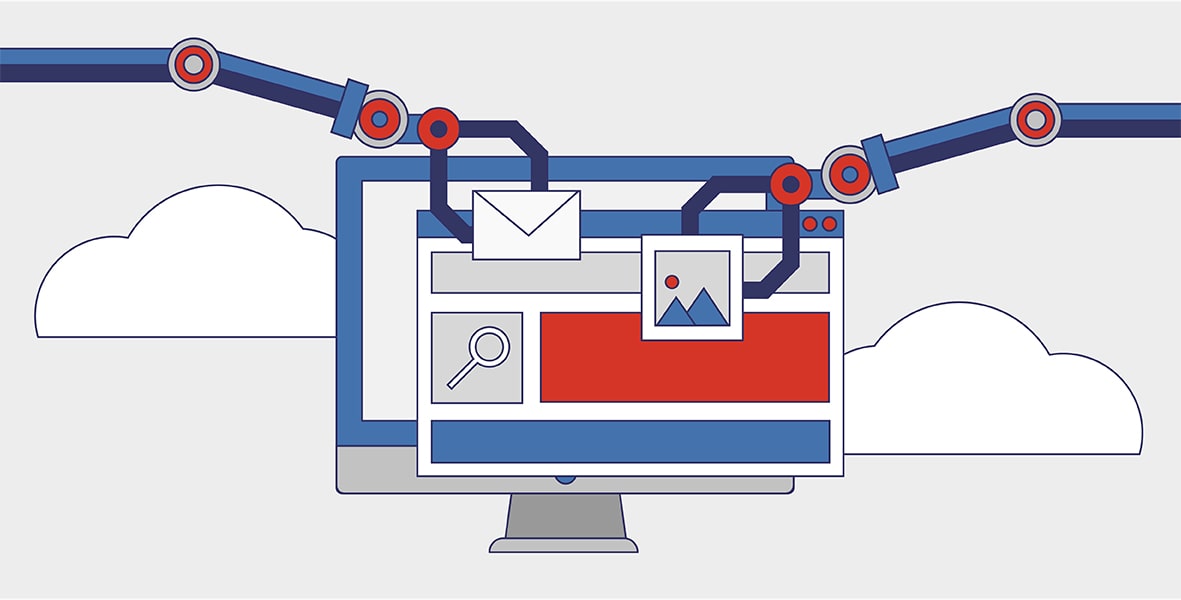Nurture Leads With Omnichannel Marketing Automation
Article - 5 Min. Read
- Exclusive star
Marketing automation has fundamentally changed the way companies engage, acquire and retain customers. Discover the most common roadblocks and best ways forward.
Marketing automation is often seen as complicated—a web of platforms and channels that needs to be integrated into a single, humming machine. The truth is it doesn’t have to be complex to bring value. To prove it, USPS Delivers spoke to experts across the automation industry to glean insights and implementation strategies so marketers at any level of familiarity can see the possibilities.[1]
Experts confirmed small and medium-sized companies are actually at an advantage with marketing automation. They can move in an agile way, adopting automation and shifting models quickly without large-scale operational challenges.
Privacy Act Statement: Your information will be used to understand the needs of customers and improve USPS sales and marketing efforts. Collection is authorized by 39 U.S.C. 401, 403, and 404. Supplying your information is voluntary, but if not provided, we may not be able to fulfill your request. We do not disclose your information to third parties without your consent, except to act on your behalf or request, or as legally required. This includes the following limited circumstances: to a congressional office on your behalf; to agents or contractors when necessary to fulfill a business function; to a U.S. Postal Service auditor; for law enforcement purposes, to labor organizations as required by applicable law; incident to proceedings involving the Postal Service, to government agencies in connection with decisions as necessary, to agencies and entities for financial matters, and for customer services purposes. For more information regarding our privacy policies visit
www.usps.com/privacypolicy
Yet many become daunted by the prospect of setting up their own automation program. The biggest reason: They go too big too soon. The experts emphasized that the best approach to creating an omnichannel marketing automation program is quite the opposite.
Rather than trying to do everything at once, today’s marketers should think iteratively. Start small and hyper-focused. Tackle the most valuable areas of opportunity and expand over time. Let’s dig into the why’s and how’s of automation.
Looking at the Benefits of Marketing Automation
Companies turn to marketing automation to nurture customer relationships and reduce marketing expenses. How does it achieve these major goals?
It’s responsive.
Marketing automation sends communications triggered and tailored to specific customer behaviors like visiting a site, interacting with customer service, or abandoning a cart.
It’s personal.
Any messages sent through digital and physical channels, like direct mail, can be tailored to a potential customer or audience segment, providing a more tailored interaction.
It’s convenient.
Once a campaign is set up and implemented, automation gets the job done, allowing a marketer to save precious hours and dollars that would have been spent manually running a campaign.
It’s effective.
Companies across B2B and B2C industries have used automation to drive key business strategies. United States Postal Service®, for example, has launched marketing automation campaigns across direct mail and digital platforms that have significantly increased the desired audience behaviors. In addition:
- One e-commerce company saw an astounding 500% increase in ROI, with order volume rising 140% as the result of an integrated marketing automation campaign.[2]
- In one survey, it was noted that 61% of overperforming leaders use their CRM to automate parts of their sales process, compared to 46% of underperforming leaders.[3]
Identifying the Common Roadblocks
- 49% of marketers say improving quality lead generation is a critical challenge to marketing automation.[4]
- 44% of marketers consider delivering personalized content to be the biggest barrier to success.[5]
Before focusing on the most optimal strategies for tackling marketing automation, it’s important to identify the most common challenges marketers face.
Going too big.
As mentioned before, marketers often bite off more than they can chew when they first tackle automation. According to the experts, many marketers see the process as one and done – once automation is turned on, all channels are working together in perfect harmony. In fact, the process should be seen as a ripple, starting with a small center and growing over time.
Leveraging personalization.
Many marketers also aren’t sure how to properly deploy personalized messages. Yet customized content has been proven to have a demonstrated lift on marketing effectiveness. Companies report that personalization efforts can boost revenues by up to 15%.[6] As an example, retargeted direct mail, an automated form of the physical channel, combines digital triggers with personalized mail to deploy a postcard or other type of mailpiece to the right customer at the right time.
Dealing with complexity.
Though marketers know that integrating digital and physical channels in a marketing automation campaign can yield greater engagement, conversion and retention, setting up campaigns can be difficult. Creating quality automations is a primary concern marketers face when using automation.
Focusing on Supportive Solutions
Experts agree that iteration is the best way to leverage marketing automation. That means creating focused campaigns, determining insights from each one, and using those results to sharpen the strategy of the next campaign.
Start small.
It’s important to strip an omnichannel strategy down to fundamentals and iterate as new campaigns are run. Set benchmarks around the most important goals and always take customer segments into account. Though marketers want to target every potential customer, it’s important to divide your audience based on important differences in demographics, interests, business verticals and beyond. Remember, the more tailored the messaging, the better the response.
Prioritize customer needs.
Think through the key customer problems and choose campaigns that you want to build momentum around. Starting small could mean a direct mail campaign that deploys a postcard when a potential customer doesn’t complete a purchase online. It could also mean focusing on lead nurturing with automated email targeting, or even improving conversion rates with automated search marketing.
Merge physical with digital.
The combination of direct mail with digital channels offers a critical integration opportunity in a multi-channel automation strategy. Digital provides the primary foundation; it’s where information can be most easily captured. Collect data through these channels and leverage it to personalize messages or set important behavioral triggers that lead to an automated communication, like direct mail.
This is true in many industries like retail, finance, travel and automotive, where direct mail can be a cornerstone of omnichannel automation. Often, once a relationship is already established online, marketers integrate a periodic mailpiece into their customer journey to seamlessly target potential customers.
Key Takeaway
When developing a marketing automation strategy, choosing what not to do is as important as choosing what to do. Rather than trying to build a complex network of campaigns and channels all at once, marketers need to identify their major goals and focus their early tests on what will bring their company the most value. Do less to achieve more.
Remember that everything won’t work perfectly, especially not in the beginning. Inherently, there are inefficiencies in marketing, but with automation there’s always room to find value.

 search
close
menu
search
close
menu



